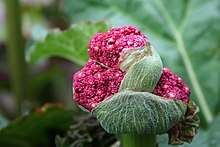Rheum australe
Rheum australe, synonym Rheum emodi, is a flowering plant in the family Polygonaceae.[1] It is commonly known as Himalayan rhubarb,[2][3], Indian rhubarb[2] and Red-veined pie plant.[2] It is a medicinal herb used in the Indian Unani system of medicine, and formerly in the European system of medicine where it was traded as Indian rhubarb.[4] The plant is found in the sub-alpine and alpine Himalayas at an altitude of 4000 m.[5]
| Rheum australe | |
|---|---|
 | |
| Scientific classification | |
| Kingdom: | Plantae |
| Clade: | Tracheophytes |
| Clade: | Angiosperms |
| Clade: | Eudicots |
| Order: | Caryophyllales |
| Family: | Polygonaceae |
| Genus: | Rheum |
| Species: | R. australe |
| Binomial name | |
| Rheum australe | |
| Synonyms[1] | |
| |
Description
The plant has a 1.5-2m high stem.[2][3] Its stem is stout, red, and streaked green and brown.[2][3] The large leaves are heart-shaped[3] or roundish with a heart-shaped base,[2] and greenish-red in colour.[3] The basal leaves can be up to 60cm wide.[2]
It has dark reddish-purple[2] or yellow flowers in late spring to summer,[3] in densely-branched clusters, in a inflorescence up to 30cm long. The inflorescence enlarges greatly when in fruit.[2]


Similar species
According to the 2003 key in the Flora of China, this species is distinguished from other entire-leaved rhubarbs in China with leaves having a wavy or crisped margin; R. wittrockii, R. rhabarbarum, R. webbianum and R. hotaoense, by having less than 1cm-sized fruit, purple-red flowers, and the surface of the rachis of panicle being densely pubescent. It is the only rhubarb in this group to have purple-red flowers as opposed to various shades of white.[6]
Karyotypy
A 1947 study found plants of R. emodi a chromosome count of 2n=22, but the same study found plants labelled as R. australe to be 2n=44. It is possible that this karyotypic diversity indicates the existence of one or more cryptic species, because the polyploid forms would essentially be reproductively isolated.[7]
Ecology
It grows on grassy or rocky slopes, crevices and moraines, forest margins, near streams and between boulders in specific zones[9]. Impatiens glandulifera in the Valley of Flowers, Uttarakhand, India.[2]
Cultivation
It is said to be quite hardy and readily propagated.[3]
Chemical constituents
Hydroxyanthracene derivatives are mainly emodin, chrysophanol and their glycosides.[10] Other hydroxyanthracene derivatives are rhein, aloe emodin and physcion and their glycosides.[11]
References
- "Rheum australe D.Don". Plants of the World Online. Royal Botanic Gardens, Kew. Retrieved 2019-03-10.
- "Rheum australe - Himalayan Rhubarb". Flowers of India. Retrieved 2 April 2019.
- Eisenreich, Dan (1996–2010). "Rhubarb Botanical Information". The Rhubarb Compendium. Retrieved 2 April 2019.
- Alam, Shamshad; Khan, Naeem A. (2015). "Rhubarb (Rewand), A Review" (PDF). Hamdard Medicus. 58 (1): 84–96. Retrieved 13 March 2019.
- Pandith, Shahzad A.; Dar, Riyaz Ahmad; Lattoo, Surrinder K.; Shah, Manzoor A.; Reshi, Zafar A. (2018-06-01). "Rheum australe, an endangered high-value medicinal herb of North Western Himalayas: a review of its botany, ethnomedical uses, phytochemistry and pharmacology". Phytochemistry Reviews. 17 (3): 573–609. doi:10.1007/s11101-018-9551-7. ISSN 1572-980X. PMC 7088705.
- Bojian (包伯坚), Bao; Grabovskaya-Borodina, Alisa E. (2003). "Rheum". In Zhengyi (吴征镒), Wu; Raven, Peter H.; Deyuan (洪德元), Hong (eds.). Flora of China, Vol. 5. Beijing: Science Press. p. 341.
- Ruirui, Liu; Wang, Ailan; Tian, Xinmin; Wang, Dongshi; Liu, Jianquan (2010). "Uniformity of karyotypes in Rheum (Polygonaceae), a species-rich genus in the Qinghai-Tibetan Plateau and adjacent regions". Caryologia Firenze. 63 (1): 82–90. doi:10.1080/00087114.2010.10589711. Retrieved 26 March 2019.
- Pandith, Shahzad A.; Dar, Riyaz Ahmad; Lattoo, Surrinder K.; Shah, Manzoor A.; Reshi, Zafar A. (2018-06-01). "Rheum australe, an endangered high-value medicinal herb of North Western Himalayas: a review of its botany, ethnomedical uses, phytochemistry and pharmacology". Phytochemistry Reviews. 17 (3): 573–609. doi:10.1007/s11101-018-9551-7. ISSN 1572-980X. PMC 7088705.
- Pandith, Shahzad A.; Dar, Riyaz Ahmad; Lattoo, Surrinder K.; Shah, Manzoor A.; Reshi, Zafar A. (2018-06-01). "Rheum australe, an endangered high-value medicinal herb of North Western Himalayas: a review of its botany, ethnomedical uses, phytochemistry and pharmacology". Phytochemistry Reviews. 17 (3): 573–609. doi:10.1007/s11101-018-9551-7. ISSN 1572-980X. PMC 7088705.
- Indian Herbal Pharmacopia Vol. II, Page-123
- Shah C.S., Quadry J.S., and Bhatt J.G., Planta Med., 22, 103(1972).